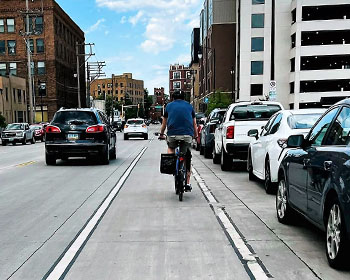Research Reports
Report Details
Abstract
 This study developed a level of traffic stress (LTS) map for Fargo-Moorhead and used crowdsourced bicycle use data from Strava to show relationships between the built environment and bicycle use. The LTS map is useful for showing how friendly and encouraging areas are toward bicycle use, as well as for showing the connectivity of low-stress pathways, and the bicycle ridership model shows how the development of bicycle facilities and other changes to the built environment are associated with bicycle use, as measured using Strava count data. The results of the bicycle use model show that the existence of bicycle facilities is positively associated with bicycle use. This suggests that bicyclists are using the roadway design features that are meant to accommodate them, including shared-use paths, bike lanes, buffered lanes, shared-lane markings, signed-only routes, and shoulders. Other significant predictors of bicycle use included industrial employment density, which was negative, proximity to downtown or to water, low-stress connectivity, traffic volume and speed, which had unexpected positive effects, and median age.
This study developed a level of traffic stress (LTS) map for Fargo-Moorhead and used crowdsourced bicycle use data from Strava to show relationships between the built environment and bicycle use. The LTS map is useful for showing how friendly and encouraging areas are toward bicycle use, as well as for showing the connectivity of low-stress pathways, and the bicycle ridership model shows how the development of bicycle facilities and other changes to the built environment are associated with bicycle use, as measured using Strava count data. The results of the bicycle use model show that the existence of bicycle facilities is positively associated with bicycle use. This suggests that bicyclists are using the roadway design features that are meant to accommodate them, including shared-use paths, bike lanes, buffered lanes, shared-lane markings, signed-only routes, and shoulders. Other significant predictors of bicycle use included industrial employment density, which was negative, proximity to downtown or to water, low-stress connectivity, traffic volume and speed, which had unexpected positive effects, and median age.